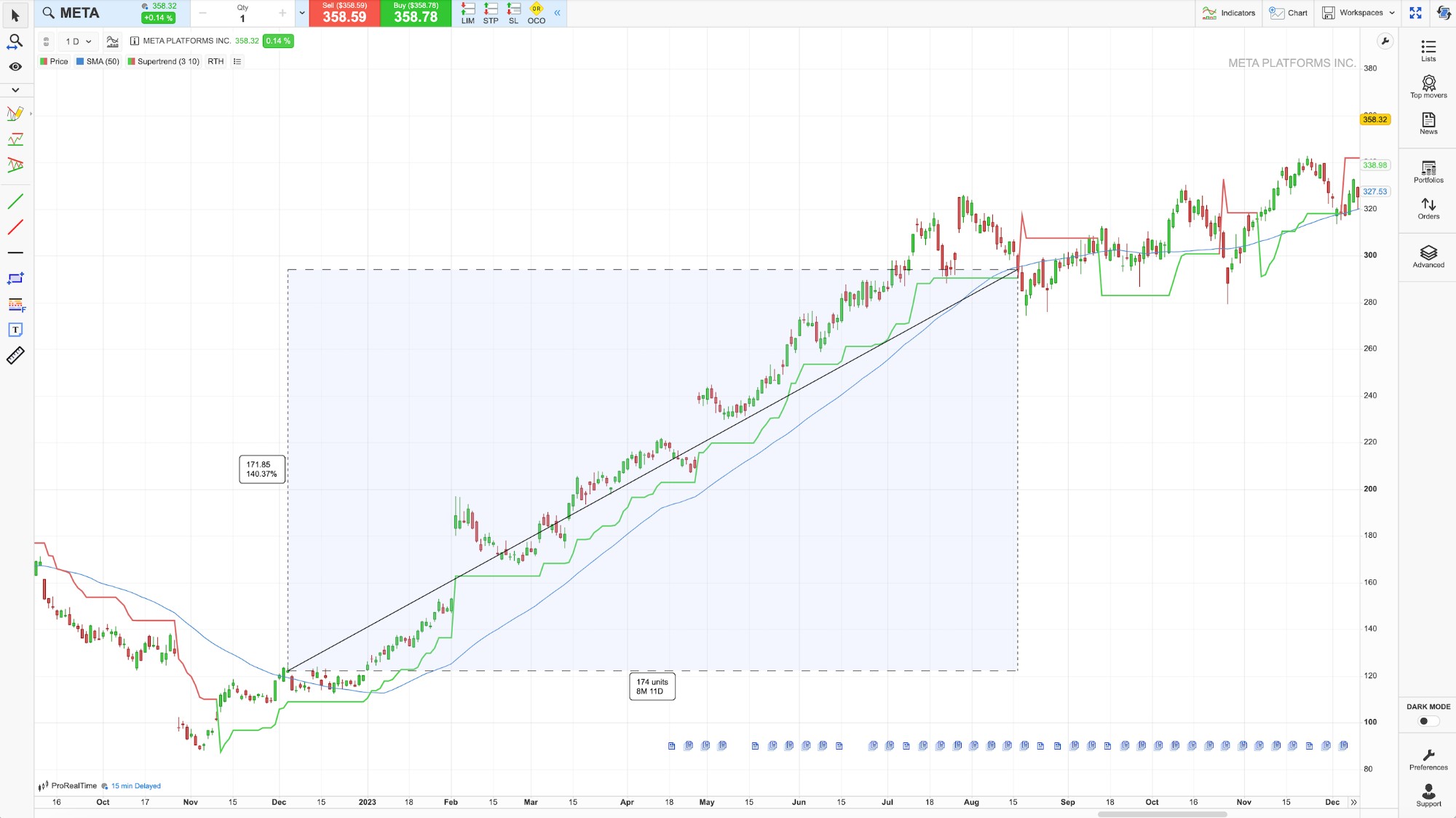Trend Trading


Trend trading is a popular strategy that capitalizes on directional movements. This guide explains the fundamentals of trend trading, offering insights into identifying trends, implementing strategies, managing risks, and optimizing entries and exits to navigate trending markets.
Quick Introduction
- Recognizing the direction of the market is essential. Use tools like moving averages, trendlines, and indicators to spot up, down, or sideways movements.
- Determine optimal entry points based on trend confirmation and stick to the trend until there’s a clear reversal.
- Use exit strategies that secure profits while considering stop-loss levels to limit potential losses.
- Maintain a risk-reward ratio, ensuring that potential profits outweigh losses. This involves setting stop-loss orders and adjusting position sizes accordingly.
- Keep a pulse on broader market sentiment, economic news, and events that could impact trends.
Best Brokers For Trend Trading
These 4 brokers are excellent options for trend traders, with strong charting packages and technical indicators:
Understanding Trend Trading
Trend trading is a strategy where you aim to profit from the directional movement of an asset.
It’s based on the principle that markets often move in discernible directions:
- Upward – bullish or uptrend
- Downward – bearish or downtrend
- Sideways – consolidation or range-bound
When trend trading you need to identify these prevailing directions and seek to enter positions in alignment with the ongoing trend.
A trend trading strategy involves analyzing historical price data, chart patterns, and technical indicators to spot and confirm trends.
Popular indicators including moving averages, trendlines, and momentum oscillators can help identify the strength and sustainability of a trend.
Once a trend has been identified, you can then look for entry points that align with the direction of that trend. For example, in an uptrend, you may look for opportunities to buy near support levels or during pullbacks within the overall upward movement.
Successfully trading trends requires riding the trend for as long as possible, aiming to capture a significant portion of the price movement.
Risk management techniques like trailing stop-loss orders will help to protect against adverse price movements and lock in profits as the trend progresses.
Trend trading requires patience, discipline, and the ability to recognize when a trend may be reversing to avoid potential losses.
Which Markets Are Suitable For Trend Trading?
Trend trading can be applied across various financial markets, including stocks, forex, commodities, indices, and cryptocurrencies.
In the stock market, individual stocks or market indices like the S&P 500 and Nasdaq often display prolonged upward or downward trends, offering opportunities to capitalize on directional movements.
In the forex market, currency pairs such as EUR/USD, GBP/JPY, and AUD/USD frequently exhibit extended trends, allowing you to ride these movements for potential profits.
Commodities like gold, crude oil, and natural gas can also experience prolonged trends, providing avenues for trend-based strategies.
Additionally, cryptocurrencies like Bitcoin, Ethereum, and others showcase trends, making them suitable for trend trading strategies.
Example Trade
Here is a Meta Platforms (META) trend trade I made for a 140%+ ROI:
- Identifying The Trend: META had been in a downtrend over several months, reaching lower highs and lower lows.
- Confirming The Trend: Using technical analysis tools including a 50-day simple moving average and a trend indicator, I noticed that META’s price had hit its 52-week low and was showing signs of a reversal.
- Entry Point: After a few days of ranging, META’s stock price rose above its 50-day simple moving average and my trend indicator turned to green, indicating a potential change in trend to the upside. Recognizing this as a potential buying opportunity, I decided to buy META shares at $119.
- Setting A Stop-Loss: To manage risk, I set a stop-loss order at $109, just above the trend indicator’s support level. This meant that if the price dropped to $109 (-8.40%), my position would automatically sell to control potential losses.
- Executing The Trade: After placing a market buy order for META at $119 and simultaneously setting a stop-loss order at $109, I held onto the position until the stock fell below its 50-day simple moving average again and the trending indicator signalled a reversal by turning red.
- Result: The trade yielded a return of 148%. However, during the entire trade, I moved my stop-loss to follow the price in order to secure profits in case of an unexpected trend reversal. Alternatively, I could have set a trailing stop.

When trend trading, consider using trailing stops. These stops adjust as the price moves in your favor, locking in profits while allowing for potential further gains if the trend continues.
Pros And Cons Of Trend Trading
- Clear Directional Signals: Trend trading lets you ride the momentum of established trends, reducing ambiguity in decision-making.
- Defined Entry & Exit Points: Trend trading strategies often rely on established entry and exit criteria based on trend indicators or technical analysis, helping you to plan positions more effectively.
- Fewer Trades: Compared to strategies involving frequent market entries and exits, trend trading typically involves fewer transactions. This reduces trading costs and mitigates the impact of short-term market fluctuations.
- Ride Strong Market Moves: During strong trends, markets can move substantially in one direction. Trend trading lets you maximize profit potential during such periods of robust market momentum.
- False Signals & Whipsaws: False signals can lead to trades that appear promising initially but then reverse quickly. These whipsaw movements can result in losses, especially when trends are short-lived or lack conviction.
- Range-Bound Markets: In markets lacking clear trends, you may struggle to find suitable opportunities. Sideways or range-bound markets can lead to limited or no profitable trades, potentially resulting in missed opportunities.
- Difficulty In Identifying Trend Reversals: Inexperienced traders may find it challenging to determine when a trend is about to reverse. Exiting a trade too early or too late can lead to missed profits or increased losses.
- Emotional Challenges During Drawdowns: Extended periods of drawdowns or losses can test your emotional resilience. Sticking to a trend strategy during losing streaks can be psychologically challenging and may lead to emotional decision-making.
- Potential For Late Entries Or Exits: You may enter or exit positions late due to waiting for confirmation of a trend. This cautious approach might result in missing the initial part of a strong trend or staying in a trade longer than necessary, reducing overall profitability.
Bottom Line
Trend trading involves capitalizing on directional market movements, aiming to profit from sustained price trends.
You’ll need to identify and ride established market trends, whether upward or downward, using various technical analysis tools to enter and exit positions.
While advantageous in strong and persistent market movements, trend trading may pose challenges during market reversals, false signals, or in sideways markets, requiring you to carefully manage risk and adapt to changing market conditions.
To start trading trends, open an account with one of our top-rated brokers.
FAQ
What Is Trend Trading?
Trend trading is a strategy that involves identifying and capitalizing on the direction of prevailing market trends.
You aim to profit by following the momentum of price movements using technical analysis indicators to recognize and ride these trends, aiming to maximize gains while managing the risks associated with potential trend reversals.
How Do You Determine A Trend?
Determining a trend typically involves analyzing price action over a period, observing if it’s consistently moving in a particular direction: upward, downward, or sideways.
This assessment often utilizes technical indicators, and confirmation of a trend may involve higher highs and higher lows for an uptrend or lower highs and lower lows for a downtrend.
Is Trend Trading Profitable?
Trend trading can be profitable, but success often depends on various factors, including market conditions, risk management, and your skill in identifying and riding trends.
You may find success by capturing significant moves during extended trends, but you might struggle in volatile or choppy markets.
Effective risk management and an understanding of market dynamics are crucial to maximizing profits and mitigating losses while trend trading.
What Is The Difference Between Trend Trading And Momentum Trading?
While trend trading seeks to ride the broader market trends, momentum trading concentrates on shorter-term bursts of price activity, targeting stocks or assets showing strong price movement irrespective of the prevailing trend.
Both approaches rely on technical analysis but diverge in their emphasis on the duration and strength of price movements.
What Is The Difference Between Trend Trading And Swing Trading?
Trend trading tends to be more patient, requiring you to withstand potential minor fluctuations, while swing trading involves more frequent transactions and quicker exits to capitalize on shorter-term price movements.
Both strategies rely on technical analysis, but the difference lies in the time frame and the depth of market analysis they require to identify and execute trades.
Article Sources
The writing and editorial team at DayTrading.com use credible sources to support their work. These include government agencies, white papers, research institutes, and engagement with industry professionals. Content is written free from bias and is fact-checked where appropriate. Learn more about why you can trust DayTrading.com



